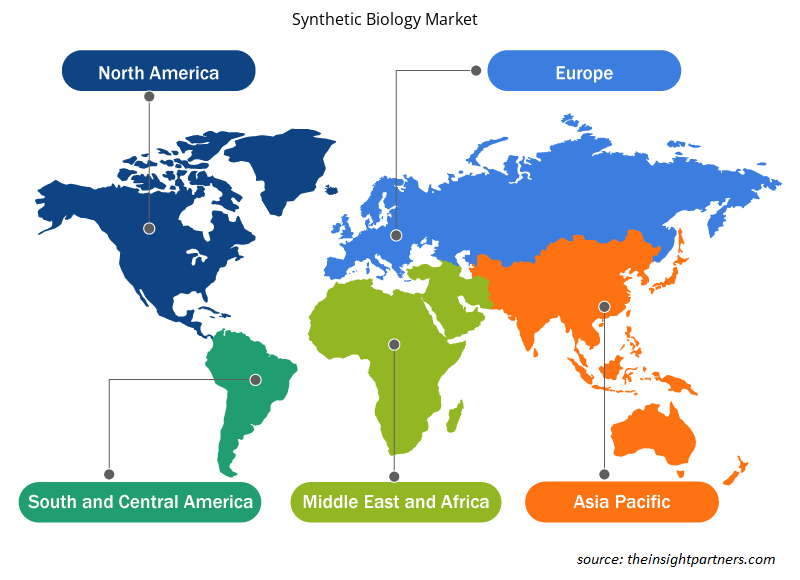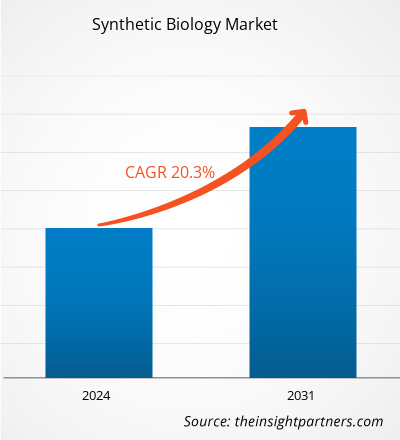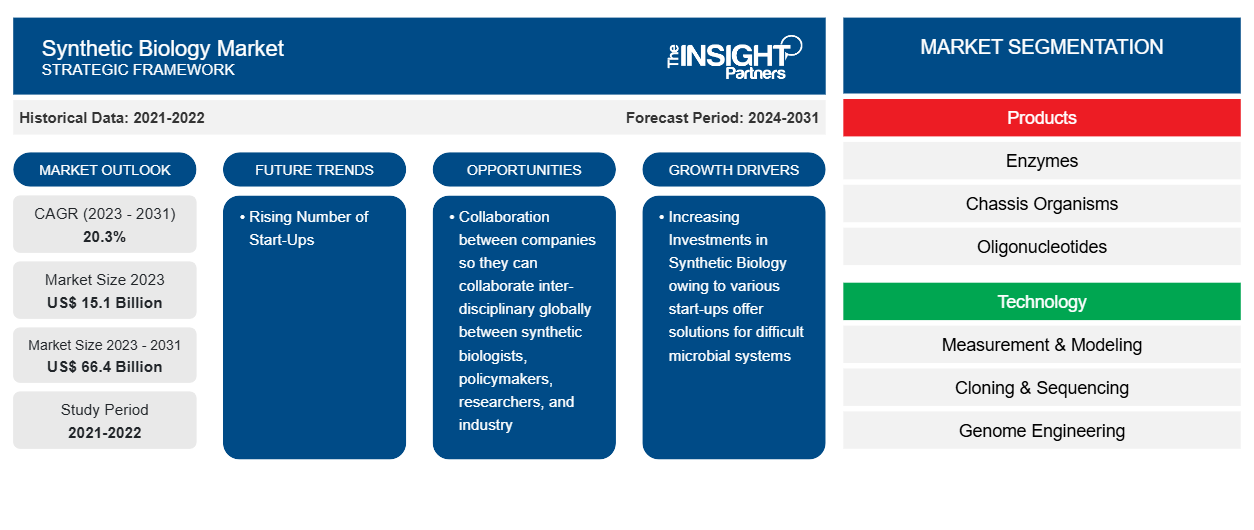Der Markt für synthetische Biologie soll von 15,1 Milliarden US-Dollar im Jahr 2023 auf 66,4 Milliarden US-Dollar im Jahr 2031 anwachsen. Für den Zeitraum 2023–2031 wird ein durchschnittliches jährliches Wachstum von 20,3 % erwartet. Fortgeschrittene synthetische Biologie dürfte ein wichtiger Trend auf dem Markt bleiben.CAGR of 20.3% during 2023–2031. Advanced synthetic biology is likely to remain a key trend in the market.
Synthetische Biologie Marktanalyse
Wichtige Faktoren für das Marktwachstum sind zunehmende Investitionen in synthetische Biologie und die steigende Zahl von Start-ups. Die synthetische Biologie bietet Unternehmen ein breites Spektrum an Möglichkeiten zur interdisziplinären globalen Zusammenarbeit zwischen synthetischen Biologen, politischen Entscheidungsträgern, Forschern und der Industrie. So kündigte Codex DNA im August 2021 eine Zusammenarbeit im Bereich der synthetischen Biologie mit dem US-Landwirtschaftsministerium an, um skalierbare therapeutische Maßnahmen gegen die Zitrus-Grünfärbung zu identifizieren.U.S. Department of Agriculture to identify scalable therapeutic measures against citrus greening disease.
Marktübersicht für synthetische Biologie
Synthetische Biologie ist ein aufstrebendes Konzept mit zahlreichen Anwendungen in den Bereichen Chemie, Landwirtschaft, Pharmazie und Energie. Verschiedene Start-ups bieten Lösungen für komplexe mikrobielle Systeme. Das US-Start-up Asimov beispielsweise bietet eine genetische Designplattform für die synthetische Biologie von Säugetieren. Sie integrieren synthetische Biologie, Multi-Omics-Messungen, computergestützte Modellierung und maschinelles Lernen in einer einzigen Plattform, um therapeutische Anwendungen voranzutreiben. Darüber hinaus bietet Benchling CAD-Tools, GenScript bietet Gensynthese, Ginkgo Bioworks hilft bei der Organismustechnik, Transcriptis (ein Bioinformatik-Unternehmen) bietet Lösungen zur Erleichterung von Cloud-Laboren/Automatisierung und Glowee bietet Verbraucherprodukte an.
Passen Sie diesen Bericht Ihren Anforderungen an
Sie erhalten kostenlos individuelle Anpassungen an jedem Bericht, einschließlich Teilen dieses Berichts oder einer Analyse auf Länderebene, eines Excel-Datenpakets sowie tolle Angebote und Rabatte für Start-ups und Universitäten.
- Holen Sie sich die wichtigsten Markttrends aus diesem Bericht.Dieses KOSTENLOSE Beispiel umfasst eine Datenanalyse von Markttrends bis hin zu Schätzungen und Prognosen.
Treiber und Chancen des Marktes für synthetische Biologie
Steigende Zahl an Gründungen
Biotechnologie-Unternehmer können rasch Geldmittel aufbringen und sich von den Regierungen ihrer Länder Ausrüstung und Räumlichkeiten beschaffen. So finanzierte die indische Regierung beispielsweise IITM Bioincubator, eine Abteilung des Indian Institute of Technology Madras, um eine Einrichtung für bioinformatische Infrastruktur und ein hochmodernes Forschungszentrum für Krebsbiologie aufzubauen. Zu den Geldern gehörten Organisationen wie das Department of Science and Technology (DST), das Department of Biotechnology (DBT) und der Council of Scientific and Industrial Research (CSIR). In China ist Chinaccelerator ein Finanzier, der Mentorenprogramme zur Unterstützung von Start-ups anbietet. Er ist außerdem mit SOSV Investments LLC verbunden, das bei der Gründung von Start-ups hilft, indem es über Programme wie RebelBio und Indie Bio Gelder bereitstellt. Die leichte Verfügbarkeit von Geldern für Ideen motiviert Unternehmer auf der ganzen Welt, Unternehmen im Bereich der synthetischen Biologie zu gründen.IITM Bioincubator, a division of the Indian Institute of Technology Madras, to establish a bioinformatics infrastructure facility and a cutting-edge cancer biology research center. Organizations include the Department of Science and Technology (DST), the Department of Biotechnology (DBT), and the Council of Scientific and Industrial Research (CSIR) contributed the funding. In China, Chinaccelerator is a financer that provides mentorship programs to help start-ups. It is also associated with SOSV Investments LLC, which helps in the establishment of start-ups by providing funds through programs such as RebelBio and Indie Bio. The easy availability of funds for ideas motivates entrepreneurs worldwide to establish synthetic biology businesses.
Zusammenarbeit zwischen Unternehmen
Die synthetische Biologie ist der Zweig der Biotechnologie , der Chancen für nahezu jeden Aspekt des Gesundheitssektors bietet, darunter Arzneimittelverabreichung, Proteintherapeutika, Biokraftstoffe sowie die Entwicklung von Lebensmitteln und landwirtschaftlichen Produkten. Sie bietet Biotechnologieunternehmern die Möglichkeit, Entdeckungen zu beschleunigen, klinische Misserfolge zu reduzieren und kosteneffizienter zu sein. Die synthetische Biologie bietet Unternehmen ein breites Spektrum an Möglichkeiten zur interdisziplinären globalen Zusammenarbeit zwischen synthetischen Biologen, politischen Entscheidungsträgern, Forschern und der Industrie. So arbeiteten beispielsweise im August 2021 Riffyn Inc. und das Centre for Synthetic Biology (IC-CSynB) des Imperial College zusammen, und SynbiCITEs London Biofoundry setzt sich für die synthetische Biologieforschung und -ausbildung im Bereich wissenschaftliche Reproduzierbarkeit ein. Dies sind die Hauptfaktoren, die Unternehmen auf dem Markt für synthetische Biologie wachsen lassen und die wahrscheinlich das Marktwachstum im Prognosezeitraum beeinflussen werden.biofuels, and food and agricultural product development. It provides opportunities for biotechnology entrepreneurs to accelerate discovery, reduce clinical failures, and be more cost-efficient. Synthetic biology offers companies a broad scope of opportunities to collaborate inter-disciplinary globally between synthetic biologists, policymakers, researchers, and industry. For instance, in August 2021, Riffyn Inc. and Imperial College’s Centre collaborated for Synthetic Biology (IC-CSynB), and SynbiCITE’s London Biofoundry sets for synthetic biology research and education in scientific reproducibility. These are the primary factors that make companies grow in the synthetic biology market and are likely to impact market growth in the forecast period.
Segmentierungsanalyse des Marktberichts zur synthetischen Biologie
Wichtige Segmente, die zur Ableitung der Marktanalyse für synthetische Biologie beigetragen haben, sind Produkt, Technologie und Anwendung.
- Basierend auf dem Produkt ist der Markt für synthetische Biologie in Enzyme, Chassisorganismen, Oligonukleotide und Xenonukleinsäuren segmentiert. Das Segment Oligonukleotide hatte im Jahr 2023 einen größeren Marktanteil.xeno-nucleic acids. The oligonucleotides segment held a larger market share in 2023.
- Nach Technologie ist der Markt in Messung und Modellierung, Klonen und Sequenzierung, Genomtechnik, Gensynthese, Nanotechnologie und andere unterteilt. Das Segment Gensynthese hatte im Jahr 2023 den größten Marktanteil.
- Nach Anwendung ist der Markt in medizinische Anwendungen, industrielle Anwendungen, Lebensmittel und Landwirtschaft, Umweltanwendungen und andere unterteilt. Das Segment der medizinischen Anwendungen hatte im Jahr 2023 den größten Marktanteil.
Synthetische Biologie Marktanteilsanalyse nach Geografie
Der geografische Umfang des Marktberichts zur synthetischen Biologie ist hauptsächlich in fünf Regionen unterteilt: Nordamerika, Asien-Pazifik, Europa, Naher Osten und Afrika sowie Süd- und Mittelamerika.
Die synthetische Biologie ist ein wichtiges Instrument für biologische Fortschritte, das Potenzial für die Entwicklung biologischer Waffen bietet, mögliche unvorhergesehene negative Auswirkungen auf die menschliche Gesundheit und potenzielle Auswirkungen auf die Umwelt hat. Sicherheitsprobleme können vermieden werden, indem der Einsatz von Biotechnologie in der Industrie durch politische Gesetze reguliert wird.
Die verschiedenen staatlichen Initiativen und Finanzierungsangebote unterstützen das Wachstum des Marktes für synthetische Biologie in den USA hervorragend. Laut einem Bericht des National Center for Biotechnology Information (NCBI) stellt die US-Regierung beispielsweise jährlich etwa 220 Millionen US-Dollar für die Forschung und Entwicklung im Bereich der synthetischen Biologie bereit. Dieser Fonds umfasst Investitionen des Energieministeriums, der National Science Foundation (NSF), des Verteidigungsministeriums (DoD) (einschließlich DARPA), der National Institutes of Health (NIH) und des US-Landwirtschaftsministeriums (USDA).
Regionale Einblicke in den Markt für synthetische Biologie
Die regionalen Trends und Faktoren, die den Markt für synthetische Biologie im Prognosezeitraum beeinflussen, wurden von den Analysten von Insight Partners ausführlich erläutert. In diesem Abschnitt werden auch die Marktsegmente und die Geografie der synthetischen Biologie in Nordamerika, Europa, im asiatisch-pazifischen Raum, im Nahen Osten und Afrika sowie in Süd- und Mittelamerika erörtert.

- Erhalten Sie regionalspezifische Daten zum Markt für synthetische Biologie
Umfang des Marktberichts zur synthetischen Biologie
| Berichtsattribut | Details |
|---|---|
| Marktgröße im Jahr 2023 | 15,1 Milliarden US-Dollar |
| Marktgröße bis 2031 | 66,4 Milliarden US-Dollar |
| Globale CAGR (2023 - 2031) | 20,3 % |
| Historische Daten | 2021-2022 |
| Prognosezeitraum | 2024–2031 |
| Abgedeckte Segmente | Nach Produkten
|
| Abgedeckte Regionen und Länder | Nordamerika
|
| Marktführer und wichtige Unternehmensprofile |
|
Marktteilnehmerdichte: Der Einfluss auf die Geschäftsdynamik
Der Markt für synthetische Biologie wächst rasant, angetrieben durch die steigende Nachfrage der Endnutzer aufgrund von Faktoren wie sich entwickelnden Verbraucherpräferenzen, technologischen Fortschritten und einem größeren Bewusstsein für die Vorteile des Produkts. Mit steigender Nachfrage erweitern Unternehmen ihr Angebot, entwickeln Innovationen, um die Bedürfnisse der Verbraucher zu erfüllen, und nutzen neue Trends, was das Marktwachstum weiter ankurbelt.
Die Marktteilnehmerdichte bezieht sich auf die Verteilung der Firmen oder Unternehmen, die in einem bestimmten Markt oder einer bestimmten Branche tätig sind. Sie gibt an, wie viele Wettbewerber (Marktteilnehmer) in einem bestimmten Marktraum im Verhältnis zu seiner Größe oder seinem gesamten Marktwert präsent sind.
Die wichtigsten auf dem Markt für synthetische Biologie tätigen Unternehmen sind:
- THERMO FISHER SCIENTIFIC INC
- Agilent Technologies, Inc.
- MERCK KGaA
- New England Biolabs
- Integrierte DNA-Technologien
- Twist Bioscience
Haftungsausschluss : Die oben aufgeführten Unternehmen sind nicht in einer bestimmten Reihenfolge aufgeführt.

- Überblick über die wichtigsten Akteure auf dem Markt für synthetische Biologie
Neuigkeiten und aktuelle Entwicklungen zum Markt für synthetische Biologie
Der Markt für synthetische Biologie wird durch die Erhebung qualitativer und quantitativer Daten aus Primär- und Sekundärforschung bewertet, die wichtige Unternehmensveröffentlichungen, Verbandsdaten und Datenbanken umfasst. Nachfolgend sind einige der Entwicklungen auf dem Markt für synthetische Biologie aufgeführt:
- bit.bio und Ginkgo Bioworks haben bit.bio als ersten Partner des Ginkgo Technology Network bekannt gegeben. Das neu gegründete Netzwerk ist ein bahnbrechendes Ökosystem aus hochmodernen Technologiepartnern, die sich der Zusammenarbeit mit Ginkgo verschrieben haben, um neue, integrierte Fähigkeiten bereitzustellen, die den Erfolg von F&E-Programmen der Kunden vorantreiben. (Quelle: bit.bio, Unternehmenswebsite, Februar 2024)
- Sumitomo Chemical Co., Ltd und Ginkgo Bioworks haben ein neues Programm zur Entwicklung funktioneller Chemikalien mit synthetischer Biologie angekündigt und erweitern damit die bestehende Partnerschaft der Unternehmen im Bereich der Bioproduktion. (Quelle: Sumitomo Chemical Co., Ltd, Unternehmenswebsite, Juli 2023)
Marktbericht zur synthetischen Biologie – Umfang und Ergebnisse
Der Bericht „Marktgröße und Prognose für synthetische Biologie (2021–2031)“ bietet eine detaillierte Analyse des Marktes, die die folgenden Bereiche abdeckt:
- Marktgröße und Prognose für synthetische Biologie auf globaler, regionaler und Länderebene für alle wichtigen Marktsegmente, die im Rahmen des Berichts abgedeckt sind
- Markttrends und Marktdynamiken im Bereich der synthetischen Biologie, darunter Treiber, Hemmnisse und wichtige Chancen
- Detaillierte PEST/Porters Five Forces- und SWOT-Analyse
- Analyse des Marktes für synthetische Biologie, die wichtige Markttrends, globale und regionale Rahmenbedingungen, wichtige Akteure, Vorschriften und aktuelle Marktentwicklungen umfasst.
- Branchenlandschaft und Wettbewerbsanalyse, einschließlich Marktkonzentration, Heatmap-Analyse, prominenten Akteuren und aktuellen Entwicklungen auf dem Markt für synthetische Biologie
- Detaillierte Firmenprofile
- Historische Analyse (2 Jahre), Basisjahr, Prognose (7 Jahre) mit CAGR
- PEST- und SWOT-Analyse
- Marktgröße Wert/Volumen – Global, Regional, Land
- Branchen- und Wettbewerbslandschaft
- Excel-Datensatz
Aktuelle Berichte
Verwandte Berichte
Erfahrungsberichte
Grund zum Kauf
- Fundierte Entscheidungsfindung
- Marktdynamik verstehen
- Wettbewerbsanalyse
- Kundeneinblicke
- Marktprognosen
- Risikominimierung
- Strategische Planung
- Investitionsbegründung
- Identifizierung neuer Märkte
- Verbesserung von Marketingstrategien
- Steigerung der Betriebseffizienz
- Anpassung an regulatorische Trends





















 Kostenlose Probe anfordern für - Markt für synthetische Biologie
Kostenlose Probe anfordern für - Markt für synthetische Biologie